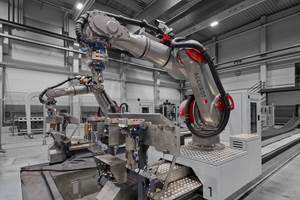NASA selects Blue Origin as second Artemis lunar lander provider
Blue Origin joins SpaceX in design, development, testing and verification of its lander concept to enable recurring astronaut expedients to the moon per the NASA Artemis program.
To develop a human landing system for the agency’s Artemis V mission to the moon, NASA (Washington, D.C., U.S.) has selected Blue Origin (Kent, Wash., U.S.). Through Artemis, NASA will explore more of the moon than ever before, uncovering more scientific discoveries, and preparing for future astronaut missions to Mars.
Blue Origin will design, develop, test and verify its Blue Moon lander to meet NASA’s human landing system requirements for recurring astronaut expeditions to the lunar surface, including docking with Gateway, a space station where crew transfer in lunar orbit. In addition to design and development work, the contract includes one uncrewed demonstration mission to the lunar surface before a crewed demo on the Artemis V mission in 2029. The total award value of the firm-fixed price contract is $3.4 billion.
“We are in a golden age of human spaceflight, which is made possible by NASA’s commercial and international partnerships,” Bill Nelson, NASA administrator, says. “Together, we are making an investment in the infrastructure that will pave the way to land the first astronauts on Mars.”
By supporting industry’s development of innovative human landing system concepts and designs, NASA hopes to increase access to space for the benefit of all.
For the Artemis V mission, NASA’s space launch system (SLS) rocket will launch four astronauts to lunar orbit aboard the Orion spacecraft (which uses composite materials). Once Orion docks with Gateway, two astronauts will transfer to Blue Origin’s human landing system for about a week-long trip to the moon’s South Pole region where they will conduct science and exploration activities. Artemis V is at the intersection of demonstrating NASA’s initial lunar exploration capabilities and establishing the foundational systems to support recurring complex missions in lunar orbit and on the surface as part of the agency’s moon to Mars exploration approach.
Adding another human landing system partner to NASA’s Artemis program will reportedly increase competition, reduce costs to taxpayers, support a regular cadence of lunar landings, further invest in the lunar economy and help NASA achieve its goals on and around the moon in preparation for future astronaut missions to Mars.
The agency previously contracted SpaceX (Hawthorne, Calif., U.S.) to demonstrate an initial human landing system for the Artemis III mission. Under that contract, the agency also directed SpaceX to evolve its design to meet the agency’s requirements for sustainable exploration and to demonstrate the lander on Artemis IV. As a result of the contract with Blue Origin to demonstrate on Artemis V a lander that meets these same sustainable lander requirements, including capabilities for increased crew size, longer mission duration and delivery of more mass to the moon, multiple providers will be available to compete for future opportunities to fulfill NASA’s lunar surface access needs for Artemis missions.
By supporting industry’s development of innovative human landing system concepts and designs, NASA hopes to increase access to space for the benefit of all.
“Having two distinct lunar lander designs, with different approaches to how they meet NASA's mission needs, provides more robustness and ensures a regular cadence of moon landings,” says Lisa Watson-Morgan, manager, Human Landing System Program at NASA’s Marshall Space Flight Center in Huntsville, Alabama. “This competitive approach drives innovation, brings down costs and invests in commercial capabilities to grow the business opportunities that can serve other customers and foster a lunar economy.”
NASA issued the solicitation, known as Appendix P, of its second Next Space Technologies for Exploration Partnerships Broad Agency Announcement (Next-STEP2 BAA), in September 2022 as part of the ongoing development of advanced space exploration technologies, capabilities and concepts.
Related Content
Rocket Lab begins installation of large AFP machine for rocket production
The 99-ton AFP machine, custom-designed and built by Electroimpact, is claimed to be the largest of its kind, expecting to save around 150,000 manufacturing hours in the Neutron rocket’s production process.
Read MoreHigh glass transition temperature, 100% bio-based thermoset resins for space composites
With the European Commission Restrictions Roadmap soon banning entire classes of chemical substances found in fossil fuel-based synthetic polymers, the space industry is looking to a chemical combination to produce competitive thermoset resins.
Read MoreAutomated robotic NDT enhances capabilities for composites
Kineco Kaman Composites India uses a bespoke Fill Accubot ultrasonic testing system to boost inspection efficiency and productivity.
Read MoreNew GTL breakthrough in composite tubing for liquid hydrogen in aircraft and space vehicles
Tests versus stainless steel tubing show 10 times faster chill down, fuel flow in 2 seconds and less boil-off for significantly faster fueling and refueling of LH2-powered space vehicles, aircraft and trucks.
Read MoreRead Next
Plant tour: Daher Shap’in TechCenter and composites production plant, Saint-Aignan-de-Grandlieu, France
Co-located R&D and production advance OOA thermosets, thermoplastics, welding, recycling and digital technologies for faster processing and certification of lighter, more sustainable composites.
Read MoreVIDEO: High-volume processing for fiberglass components
Cannon Ergos, a company specializing in high-ton presses and equipment for composites fabrication and plastics processing, displayed automotive and industrial components at CAMX 2024.
Read More“Structured air” TPS safeguards composite structures
Powered by an 85% air/15% pure polyimide aerogel, Blueshift’s novel material system protects structures during transient thermal events from -200°C to beyond 2400°C for rockets, battery boxes and more.
Read More















.jpg;maxWidth=300;quality=90)











